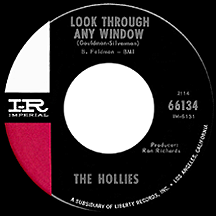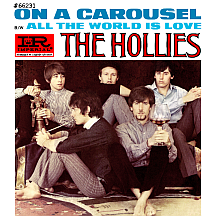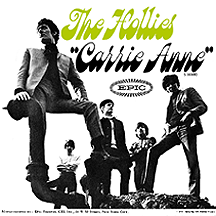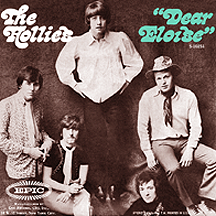THE HOLLIES
Allan Clarke and Graham Nash became fast friends during elementary school in their home city of Manchester, England, and by their teens, like many British kids, they were caught up in the skiffle movement of the mid-1950s. As budding performers they went by a variety of names in those years: The Guytones, The Two Teens and/or The Twotones, expanding to The Fourtones when joined by two others, and as the duo Ricky and Dane in an attempt to pass themselves off as brothers in imitation of The Everly Brothers, an early favorite. The Everlys, in fact, served as a major source of inspiration well into Allan's and Graham's professional alliance.
They came closer to that professional level when the two joined another group in the vicinity, The Deltas, which included bass guitarist Eric Haydock. Breaking from the Deltas, retaining Haydock and adding Vic Steele on lead guitar and Don Rathbone on drums, the five chose The Hollies, a cross between Buddy Holly (another favorite) and holly (that of the Christmas wreath) as a temporary name when the group first performed together in public in December 1962. A regular gig at the Cavern Club in Liverpool, where a group of guys named John, Paul, George and Pete had packed in the crowds just months before, brought them to the attention of Ron Richards of EMI. Just as The Beatles had done, they signed a contract with Parlophone Records and the Hollies name became permanent. For whatever reason, Steele got cold feet about being a pro and was replaced by Tony Hicks of another area group, The Dolphins, just before the first recording sessions. Rathbone left a few months later and Tony's pal, Dolphins drummer Bobby Elliott, came on board.
A reasonable misgiving from the point of view of someone from the U.S., like myself, would be whether it was such a good idea for the U.K. bands of that period to depend so heavily on recording cover versions of American pop and R&B songs for consumption by the British public. Nearly everyone was doing it in '62 and '63, releasing mostly-inferior retreads (the Beatles being one of the few exceptions, going with originals for their 45s and committing the covers to their albums). The Hollies, however, first came into earshot with Everly-styled harmonies on R&B songs, a not altogether unappealing approach, starting with a pair of remakes taken from The Coasters, "(Ain't That) Just Like Me" and "Searchin'," both sizeable hits, followed by "Stay" of Maurice Williams and the Zodiacs fame and Doris Troy's "Just One Look," taking them into 1964, each single a bigger U.K. hit than the one before it.
In America, the Hollies showed up late for the British Invasion, but it wasn't for lack of effort. Radio programmers and music fans just didn't let them into the party. First "Stay," on Liberty, was passed over in the first few weeks of '64's Beatlemania, then sister label Imperial released "Just One Look"...but how could anyone compete with, much less improve on, a powerhouse like the Doris Troy hit from less than a year earlier in its country of origin? Well, unless they're The Searchers, who somehow repeatedly pulled off the cover/remake approach, the answer is simple: they couldn't...or at best would face an uphill battle. So the song faltered early on and the group was in a bit of a pickle while other acts were riding the wave successfully across the ocean and onto the American charts. Nothing clicked for over a year. With eight consecutive hit singles in England to the group's credit, Imperial released the biggest of these, their first number one U.K. hit, in the summer of 1965. Composed by Clint Ballard, Jr., an American who'd written "Game of Love" (a number one smash in the U.S. in April for Wayne Fontana and the Mindbenders), "I'm Alive" was a terrific song worthy of hitting big, but it struggled to get any airplay at the same time the Stones were achieving great "Satisfaction" with a song that claimed they couldn't get any. The Hollies had to consider the possibility that the Atlantic Ocean crossover wasn't going to happen for them.
They had made the switch to original material: "I'm Alive" and its follow-up, while not written by any group members, were composed for them by established writers. In the States at least, moving away from remakes of known hits gave them a better shot at finding an audience. Near the end of 1965, almost two years after the Beatles had gotten the invasion rolling, the group finally scored its first top 40 hit in America, the Graham Gouldman-Charles Silverman song "Look Through Any Window," and suddenly radio programmers' resistance to them eased up. "I Can't Let Go," written by Chip Taylor and Al Gorgoni, was released by Evie Sands in late '65 but failed to get anywhere. The group's version charted respectably in early '66, though the really big breakthrough song was still ahead of them.
Haydock left the group around that time in a disagreement with management; Bernie Calvert took over as bass player. Hicks, Clarke and Nash had begun writing songs for the B sides if for no other reason than the extra royalty money, and this evolved into more serious efforts and, eventually, the A sides. Before they took that task on permanently, Gouldman (later of '70s band 10cc) wrote one last single for the group; "Bus Stop," an appealing bit of prose about a couple falling in love while sharing an umbrella, hit the airwaves that summer and became the top ten American smash the group had been waiting a long time for.
Finally on track as stateside hitmakers, the songwriting team of Hicks-Clarke-Nash took the reins and were responsible for several unique singles over the next year or so, in terms of production as well as music and lyrics. Perhaps the most creative period in the band's history, it took hold with "Stop Stop Stop," describing in detail a belly dancer and the sweat-inducing reaction she imposes, and featuring the unique sound of banjo playing with a tape-delay reverb effect, an interesting experiment and one that landed them their second top ten hit in a row. The lyrics of the spring 1967 hit "On a Carousel" sparked colorful images as well, and the songwriting trio's creative juices were really flowing just as the group's U.S. contract with Imperial expired. The timing was good, as the recent run of hits caused several labels to bid for the band and they ended up negotiating a profitable deal with Epic Records. Imperial put out a few more singles, the U.S.-only release "Pay You Back With Interest" interesting for its vibrating piano intro and uncommonly-heard "ringing bells" solo.
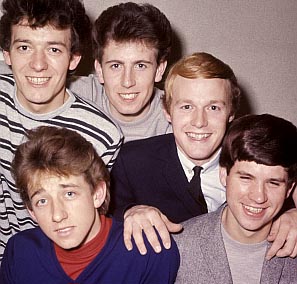
The inital single for Epic started with a socially-conscious idea and Hicks gave it the working title "Hey Mr. Man," but it instead became a romantic song about a girl named "Carrie-Anne," chosen simply because the name rhymed with "Mr. Man." This first single for the new label went top ten in the summer of '67. Nash was growing tired of all the romantic pop tunes, though, and came up with "King Midas in Reverse," a good song but with a negative vibe, which stalled halfway up the charts and quickened his decision to leave the band. "Dear Eloise" followed, another song that wasn't released on a single in England but seemed a good choice with its unconventional slow-to-fast-to-slow structure; it also fell a little shy of expectations. "Jennifer Eccles" was a love song to two women: Jennifer was the name of Clarke's wife and Nash's wife's maiden name was Eccles. It too landed mid-chart and by that time, mid-1968, the Hollies were looking a little like a one-hit act for Epic since signing their big deal.
When Graham Nash quit the group at the end of the year (he was replaced by Terry Sylvester), he headed to Los Angeles and emerged several months later as one-third of Crosby, Stills and Nash with the first of many hits, "Marrakesh Express." The Hollies ventured on with Allan Clarke as lead singer, but the lackluster reception to "Sorry Suzanne" suggested they might want to veer away from titles with girl's names. So they did, and landed back in the top ten in early 1970 with the Bobby Scott-Bob Russell composition "He Ain't Heavy, He's My Brother" (which featured Elton John on piano). Neil Diamond felt strongly enough about the song's message to release it several months later and the earlier Hollies hit apparently didn't hold the record back as it also did well, making the top 20.
The biggest of all Hollies hits was also their hardest rocker: "Long Cool Woman (In a Black Dress)" reached number two in September 1972, followed by "Long Dark Road," after which Clarke departed for a solo career, finding it difficult to pull off. When he returned a year or so later, the group had one last major hit, "The Air That I Breathe," in the summer of 1974. Written by Albert Hammond and Mike Hazlewood, the song was first recorded by Hammond, then by Phil Everly. It was Phil's version that inspired the Hollies remake, recalling the Everly Brothers influence of Clarke's and Nash's childhood. Nash, in fact, after on-again, off-again teamings with the expanded Crosby, Stills, Nash and Young (including solo recordings and duets with David Crosby and Neil Young) was open to a reunion with his original band and rejoined them in the 1980s for an album and some live performances. "Stop in the Name of Love," a remake of the 1965 chart-topper by The Supremes, hit the top 40 in July 1983, bringing The Hollies full circle with the R&B and pop covers with which the group had staked its original claim.
NOTABLE SINGLES:
- (Ain't That) Just Like Me - 1963
- Searchin' - 1963
- Stay - 1963
- Just One Look - 1964
- Here I Go Again - 1964
- I'm Alive - 1965
- Look Through Any Window - 1965
- I Can't Let Go - 1966
- Bus Stop - 1966
- Stop Stop Stop - 1966
- On a Carousel - 1967
- Pay You Back With Interest - 1967
- Carrie-Anne - 1967
- King Midas in Reverse - 1967
- Dear Eloise - 1967
- Jennifer Eccles - 1968
- Do the Best You Can - 1968
- Listen To Me - 1968
- Sorry Suzanne - 1969
- He Ain't Heavy, He's My Brother - 1970
- Long Cool Woman (In a Black Dress) - 1972
- Long Dark Road - 1972
- The Air That I Breathe - 1974
- Stop in the Name of Love - 1983


